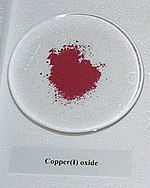Kuprum(I) oksida
Kuprum(I) oksida ialah oksida kuprum(I) yang ada formula kimia Cu2O,ialah sejenis serbuk perang merah.Ia boleh terlarut di dalam larutan asid hidroklorik,asid sulfurik dan ammonium klorida.Kuprum(I) oksida rebut di 1800℃ dan merebut ke kuprum dan oksigen,yang boleh dioksidakan ke kuprum(II) oksida di udara yang basah.

| |
| Nama | |
|---|---|
| Nama IUPAC
Copper (I) oxide
| |
| Pengecam | |
Imej model 3D Jmol
|
|
| ChemSpider | |
| ECHA InfoCard | 100.013.883 |
| Nombor EC |
|
| KEGG | |
PubChem CID
|
|
| Nombor RTECS |
|
| UNII | |
CompTox Dashboard (EPA)
|
|
| |
| |
| Sifat | |
| Cu2O | |
| Jisim molar | 143.091[1] |
| Rupa bentuk | pepejal perang[1] |
| Ketumpatan | 6.0 g/cm3[1] |
| Takat lebur | 1,244 °C (2,271 °F; 1,517 K) |
| Takat didih | 1,800 °C (3,270 °F; 2,070 K) |
| sukar terlarut[1] | |
| Keterlarutan dalam asid | mudah terlarut(kecuali asid hidroklorik) |
| Luang jalur | 2.137 |
| Struktur | |
| Struktur kristal | Kubik[1] |
| Termokimia | |
| Entropi molar piawai S |
93 J·mol−1·K−1 |
Entalpi pembentukan
piawai (ΔfH⦵298) |
−170 kJ·mol−1 |
| Bahaya | |
| Pengelasan EU | {{{value}}} |
| Frasa R | R22, Templat:R50/53 |
| Frasa S | Templat:S2, Templat:S22, Templat:S60, S61 |
| NFPA 704 (berlian api) | |
| Sebatian berkaitan | |
Anion lain
|
Kuprum(I) sulfida Kuprum sulfida Kuprum selenida |
Kation lain
|
Kuprum(II) oksida, Argentum oksida, Nikel oksida, Zink oksida |
Kecuali jika dinyatakan sebaliknya, data diberikan untuk bahan-bahan dalam keadaan piawainya (pada 25 °C [77 °F], 100 kPa). | |
| | |
| Rujukan kotak info | |
Lihat juga
suntingRujukan
sunting- N. N. Greenwood, A. Earnshaw, Chemistry of the Elements, 2nd ed., Butterworth-Heinemann, Oxford, UK, 1997.
- Handbook of Chemistry and Physics, 71st edition, CRC Press, Ann Arbor, Michigan, 1990.
- The Merck Index, 7th edition, Merck & Co, Rahway, New Jersey, USA, 1960.
- D. Nicholls, Complexes and First-Row Transition Elements, Macmillan Press, London, 1973.
- P.W. Baumeister: Optical Absorption of Cuprous Oxide, Phys. Rev. 121 (1961), 359.
- L. Brillouin: Wave Propagation and Group Velocity, Academic Press, New York, 1960.
- D. Fröhlich, A. Kulik, B. Uebbing, and A. Mysyrovicz: Coherent Propagation and Quantum Beats of Quadrupole Polaritons in Cu2O, Phys. Rev. Lett. 67 (1991), 2343.
- L. Hanke: Transformation von Licht in Wärme in Kristallen - Lineare Absorption in Cu2O, ISBN 3-8265-7269-6, Shaker, Aachen, 2000; (Transformation of light into heat in crystals - Linear absorption in Cu2O).
- L. Hanke, D. Fröhlich, A.L. Ivanov, P.B. Littlewood, and H. Stolz: LA-Phonoritons in Cu2O, Phys. Rev. Lett. 83 (1999), 4365.
- L. Hanke, D. Fröhlich, and H. Stolz: Direct observation of longitudinal acoustic phonon absorption to the 1S-exciton in Cu2O, Sol. Stat. Comm. 112 (1999), 455.
- J.J. Hopfield, Theory of the Contribution of Excitons to the Complex Dielectric Constant of Crystals, Phys. Rev. 112 (1958), 1555.
- J.P. Wolfe and A. Mysyrowicz: Excitonic Matter, Scientific American 250 (1984), No. 3, 98.
